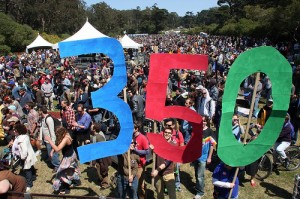
Photo by John Quigley
NASA Climate Scientist James Hanson and national climate activist Bill McKibben are pushing to move the climate debate from keeping global emissions from surpassing the original danger zone of 450 parts per million as recommended by the IPCC, to instead recognize 350 parts per million as the new limit that should not be passed. Their recommendations come from recent findings by James Hanson, that indicates that climate change is happening faster than expected and feedback loops have a greater impact on climate than originally hypothesized. At 450 parts per million, we potentially run the risk of returning the planet to conditions when it was largely ice-free, when sea levels were higher by more than 200 feet.
The 350 movement is gaining steam with a top UN Scientist signing on in support. Currently, CO2 emissions are now at 387 parts per million and it is expected by 2100 emissions could reach between 400 and 1,000 parts per million. To get back to 350 parts per million, industry, governments, and individuals will have to go way beyond the proposed reductions which are already meeting incredible resistance here in the US and overseas.
To learn more about the movement visit 350.org and on October 24th individuals and groups across the globe are taking action to build public awareness on the importance of 350 ppm and leveraging meaningful political change. The city of Cambridge has also recently passed a resolution recognizing the climate change emergency. Cambridge residents can weigh in on climate change at the Climate Emergency Forum on September 17 at the Cambridge Community Center at 7 PM and a city council hearing scheduled for September 24th.
